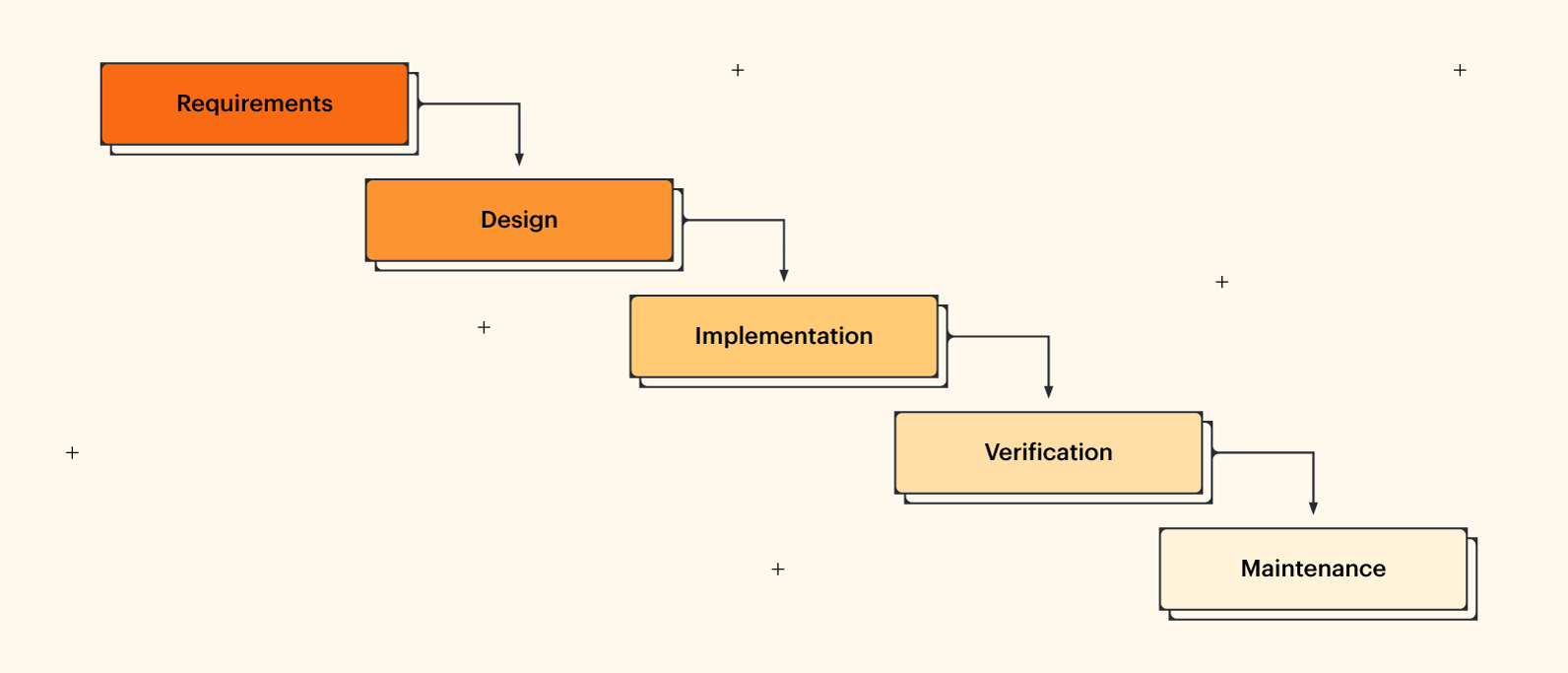
What the waterfall project management methodology can (and can’t) do for you
Reading time: about 7 min
Topics:
If you work in project management, you have probably heard a number of strange terms thrown around as you try to decide what approach will work best for your team: critical path, scrum, PMBOK, Six Sigma, etc. Amongst all these terms, you may have heard about the waterfall project management methodology, even if you’ve never used it.
Curious as to whether this approach would be a good fit for your project management needs? In this guide, learn how the waterfall methodology uses a sequential process to simplify project management and how you might implement aspects of this methodology in your own work.
What is the waterfall project management methodology?
Simply put, traditional waterfall project management is a sequential, linear process of project management. It consists of several discrete phases. No phase begins until the prior phase is complete, and each phase’s completion is terminal—waterfall management does not allow you to return to a previous phase. The only way to revisit a phase is to start over at phase one.

If waterfall methodology sounds strict, that’s because the system’s history demanded it. Waterfall project management has its roots in non-software industries like manufacturing and construction, where the system arose out of necessity. In these fields, project phases must happen sequentially. You can’t put up drywall if you haven’t framed a house. Likewise, it’s impossible to revisit a phase. There’s no good way to un-pour a concrete foundation.
As you can imagine, proper planning is a must in the waterfall system. A project’s requirements must be clear upfront, and everyone involved in a project must be well aware of those requirements. Each team member should also understand what their role will be in the project and what that role entails.
All of this information must be thoroughly documented and then distributed to everyone on the project. We recommend outlining this information as a flowchart, as shown below, so your team can quickly understand and reference requirements as needed. You may also want to try adding swimlanes to show which tasks go to which team member.
Team members will refer to the documentation you provide throughout the process. When followed properly, this document makes expectations clear. It will also provide project milestones that will make it simple to determine progress.
Consequently, thorough documentation is a priority in traditional waterfall project management methodology. Documentation should take place throughout every phase of the process, ensuring that everyone involved is on the same page despite the sequential progression of the project.
Phases of waterfall project management
The specific waterfall phases vary somewhat from source to source, but they generally include:
1. Requirement gathering and documentation
In this stage, you should gather comprehensive information about what this project requires. You can gather this information in a variety of ways, from interviews to questionnaires to interactive brainstorming. By the end of this phase, the project requirements should be clear, and you should have a requirements document that has been distributed to your team.
2. System design
Using the established requirements, your team designs the system. No coding takes place during this phase, but the team establishes specs such as programming language or hardware requirements.
3. Implementation
Coding takes place in this phase. Programmers take information from the previous stage and create a functional product. They typically implement code in small pieces, which are integrated at the end of this phase or the beginning of the next.
4. Testing
Once all coding is done, testing of the product can begin. Testers methodically find and report any problems. If serious issues arise, your project may need to return to phase one for reevaluation.
5. Delivery/deployment
In this phase, the product is complete, and your team submits the deliverables to be deployed or released.
6. Maintenance
The product has been delivered to the client and is being used. As issues arise, your team may need to create patches and updates may to address them. Again, big issues may necessitate a return to phase one.
Benefits of waterfall project management
Today, most companies use a combination of project management styles. But traditional waterfall still holds it own all these years later. In fact, a 2020 report from PMI found that companies used a traditional project management approach (like waterfall) for 56% of their projectsWhat makes this methodology successful for so many teams?
Keeps training simple
This methodology could ensure your project’s success even if there are unanticipated changes in bandwidth. Because waterfall project management emphasizes thorough documentation, you can easily and seamlessly add new team members to any project. There’s no need to intuit what an absent programmer was trying to do, as everything—from the project’s conception to its completion—is recorded. New team members can simply refer to documentation to get quickly up to speed.
Shows progress
Waterfall project management also shows progress simply. The clear milestones delineated in the first phase make it easy to determine if a project is moving forward on schedule. Likewise, the discrete phases indicate how close a project is to overall completion at any given time, as the waterfall system does not allow for revisiting a prior phase. This eliminates much of the guesswork related to a project’s timeline.
Makes the project easy to manage
These benefits, combined with the linear nature of the system, make waterfall projects easy to manage. Because of the sequential system, you’ll know where the project is at any given time and if that’s where it should be. Rather than scrambling to manage a large team, a manager can focus exclusively on team members participating in a given phase. And should there be unexpected outside delays or personnel changes, waterfall documentation allow you to quickly get your team back on track.
Saves time and money
Whether you decide to fully commit to waterfall project management, there’s no question that certain aspects of this methodology—namely, thorough conceptualization and detailed documentation—better prepare you to execute a project the right way the first time. Taking the time early on to discover and plan for requirements can save you time and money down the line.
When to use waterfall methodology
Because of its linear approach, waterfall methodology project management works best for projects that have clear and fixed requirements and/or time constraints. That’s why waterfall steps work well in manufacturing and construction industries, where schedules and plans are clear from the start.
Late-stage testing makes any revision a serious undertaking. In fact, strict adherents to the waterfall timeline would argue that a need for revision means the product requirements were not clear, and therefore the project must return to stage one. This can be a serious problem in many industries, such as the ever-changing world of software.
An agile approach is more likely to suit your project if you suspect that requirements could change during production or that revision will be necessary. Realistically, most software development fits in this category.
Because of its inability to adapt to change, the waterfall methodology is best suited to short projects that are well-defined from the beginning. If you are certain that the project requirements are static, then waterfall project management provides a straightforward way to push a project through a clearly defined process. It’s simple to manage and easy to track.
How Lucidchart can help you document your project
Want to try the waterfall methodology? Now that you’ve seen the importance of documentation within this method, you know the first step is to find a platform to track all the necessary tasks and share them with your team.
Lucidchart can help in every project stage:
- Utilize a mind map as you gather requirements. You can even share your Lucidchart document during a meeting with stakeholders and add suggestions in real time.
- If you work in software development, you might want to create a user flow diagram based on the requirements you’ve received. With this document, developers can see a high-level view of how the software should function.
- Once you finalize requirements and understand the tasks needed to accomplish those requirements, create a workflow for your team. In Lucidchart, your team will be able to see dependencies at a glance.
- Make documentation available for everyone involved with the project. Sharing is simple since you can access Lucidchart documents from any operating system or embed your diagrams into popular apps you already use in your workflow.
Try Lucidchart and see how to improve documentation throughout the entire waterfall process.

Explore all the ways Lucidchart can support project management.
Learn moreAbout Lucidchart
Lucidchart, a cloud-based intelligent diagramming application, is a core component of Lucid Software's Visual Collaboration Suite. This intuitive, cloud-based solution empowers teams to collaborate in real-time to build flowcharts, mockups, UML diagrams, customer journey maps, and more. Lucidchart propels teams forward to build the future faster. Lucid is proud to serve top businesses around the world, including customers such as Google, GE, and NBC Universal, and 99% of the Fortune 500. Lucid partners with industry leaders, including Google, Atlassian, and Microsoft. Since its founding, Lucid has received numerous awards for its products, business, and workplace culture. For more information, visit lucidchart.com.
Related articles
The pros and cons of Waterfall methodology
Learn about the pros and cons of the Waterfall methodology to determine if it's the right fit for your team.
Agile vs. Waterfall vs. Kanban vs. Scrum: What’s the Difference?
Check out our complete guide to help you understand the different project management methodologies. Understand what really sets Waterfall, Agile, Scrum, and Kanban apart and determine which is the best fit for your team.
